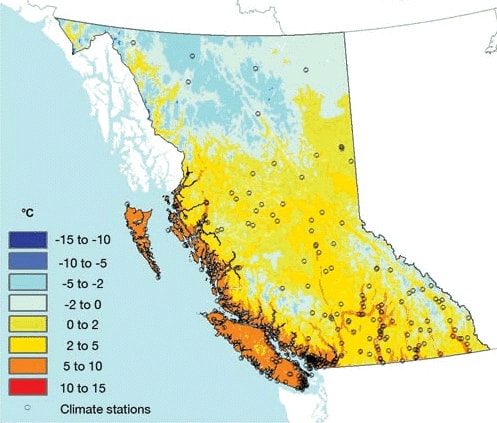How's the Weather in Greenwood?
BY: BG EDITOR

[ Map: Natural Resources Canada ]
Jul 16, 2016 — GREENWOOD, BC (BG)
A wealth of climate data has been collected over the years by the Meteorological Service of Canada, but in many locations the data has only been gathered for the last 50 years or so. Greenwood, however, has had a weather collection station operating since June 1st, 1911. The station has been recording at Longitude -118.683333, Latitude 49.1, at an elevation of 763 meters.
Like many places in the province, Greenwood is situated in its own unique micro-climate zone.
In terms of biogeoclimate research, Greenwood falls under the Nelson region. By Forestry designation, we're in the "Interior Douglas - Fir" (IDF) zone.
Here's a thumbnail sketch of Greenwood's climate statistics:
Elevation Range: from 2,450.1 feet (746.7 meters) to 2,530 ft. (770 m.)
Mean Annual Precipitation: 20.1 inches (51 centimeters)
Mean Summer Precipitation: 7.1 in. (18 cm.)
Mean Winter Precipitation: 13.0 in. (33 cm.)
Mean Precipitation in Driest Month: 1.0 in. (2.54 cm.)
Mean Precipitation in Wettest Month: 3.1 in. (7.8 cm.)
Mean Annual Snowfall: 90.4 in. (229.6 cm.)
Number of Months with Snow: 3.1/year
Mean Annual Temperature: 42.3º Fahrenheit (5.7º Celsius)
Mean Temperature in Coldest Month: 19.6º F (-6.8º C.)
Mean Temperature in Warmest Month: 63.0º F (17.2º C.)
Wettest Month: January
Driest Month: September
Number of Frost-free Days: 163
Given the unseasonably wet summer we're having in the southern interior, it seems fair to have a brief conversation about snow, in the middle of July…
While we measure the cold in degrees and the snow accumulation in inches or centimeters, there are a few other measurements of interest. One of them is the measurement of snow load, which is an important factor to keep in mind. Community guidelines on snow load help us to judge by the weight of snow on the ground, what the load is on the roof above us.
Local snow load ratings factor in the typical moisture concentration that causes snow to be light or heavy. Greenwood's snow load rating is 378 (snow load [kg/m2] on the ground, not on the building). This means that in Greenwood, a 10 meter x 10 m. flat roof building should be able to handle a the equivalent, on the roof, of 378 kg/m2 on the ground.
Another interesting metric is one that determines the number of "heating degree days". This formula assumes that once the outside temperature drops below 18º C, we're likely to reach for the thermostat.
The calculation relating coldness to predicted fuel consumption is called "heating degree days" (HDD). This number marks the difference between the average outdoor temperature and a comfortable interior temperature of 18º C. For example, a day that's 10º C outside counts as an '8 HDD' day (18 less 10 = 8HDD).
Energy companies use this data to plan power consumption trends and to schedule deliveries of heating oil and gas. But homeowners heating with wood can also use the numbers to predict how much firewood they're likely to burn over a multi-year period.





